Uh oh… You’ve found some bed bugs on your bed. You’re feeling grossed out and need it taken care of ASAP!
It’s important to note that good housekeeping may not eliminate the problem. Even upscale hotels are not immune – bed bugs can thrive in a spotlessly clean room.
Bed Bug infestations are difficult to deal with, and success depends on the thoroughness of the preparation, treatment and the follow-up. Home remedies, available in stores, are not very effective getting rid of a bed bug infestation. Your best course of action is to immediately contact us as we have extensive experience dealing with bed bugs.
Pest control professionals administer the most effective treatments. It is advised that anyone with a suspected bed bug infestation contact their local expert to arrange an inspection and consultation. Schedule your bed bug extermination now by filling out the form on the right.

Bed bugs are gray to reddish-brown in colour, are oval and flat, and are approximately 1 to 5 mm (1/16″ to 3/16″) in size. Bed bugs will be closely associated with the bed and surrounding objects such as headboards and end tables. The bat bug is similar in appearance to the bedbug, but has a heavier amount of setae on the pronotum and differs greatly in preferred habitat. Upon hatching, the nymph is a translucent flesh color which makes it difficult to see until it acquires its first blood meal – at which time is easily visible because of the red blood. The Bat bug is similar to the bed bug in appearance and an inspection should be done to determine what type is invading you.
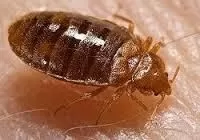
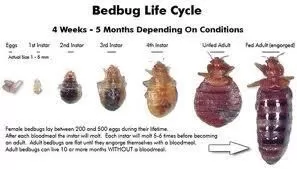
The location where the insects are found can help distinguish between them. Bat bugs feed on bats and will originate in attics and wall voids where bats are roosting. Insects found in the middle of the floor, especially during the day, with no specimens found around the bed may indicate a bat bug infestation with entry into the living space via gaps around ceiling lights and other fixtures. Once the type of insect has been determined the appropriate control measures can be implemented.
A female bed bug may deposit 1 to 5 eggs per day and may lay a total of 300-500 eggs within her lifetime. Their eggs are 1 mm long and slightly bent. They are often deposited in clusters and attached to cracks, crevices or rough surfaces near adult dwellings. The female bed bug produces a clear, sticky substance that she uses to attach each egg to the chosen surface.
Eggs hatch in 7 to 12 days depending on the conditions. There are 5 stages before a nymph bed bug reaches full maturity – each stage requires a blood feeding. This process takes approximately 4 weeks. Adult bed bugs can survive for up to one year without a blood meal.
Bedbugs harbour in hidden cracks and crevices during the day and emerge at night to take a blood meal from unsuspecting hosts. They are often associated with the sleeping quarters of an infested location as this offers a close proximity to the host. However, bedbugs can travel 10 to 100 feet for a blood meal, and will disperse to more remote areas as the infestation grows.

How to Get Rid of Bed Bugs in Your Home
Although bed bugs don’t pose any serious health concerns they do live and hide in the areas where we sleep. They are mostly found in bedding, mattresses, on headboards and in bed frames and box springs. Due to their size and nocturnal nature bed bugs can easily go undetected. Dark spots and small blood stains may indicate the presence of bed bugs. Bed bugs also give off a sweet musty odour and will often leave their eggs and molted skins near areas they have infested. Good housekeeping may not eliminate the problem. Even upscale hotels are not immune – bed bugs can thrive in a spotlessly clean room.

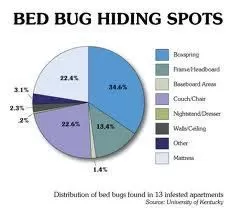
One of the most important steps in effective bed bug control is the accurate identification of bed bugs presence before starting any treatments. Home remedies, available in stores, are not very effective getting rid of a bed bug infestation. If you do choose to use an over-the-counter insecticide, make sure to read the label closely and follow directions. Your best course of action is to immediately contact us as we have extensive experience dealing with bed bugs.
Pest control professionals administer the most effective treatments. It is advised that anyone with a suspected bed bug infestation contact their local expert to arrange an inspection and consultation.
There is no way to prevent bed bugs entirely; however, experts agree that early detection is the best way to prevent them from establishing themselves.
To prevent bed bug infestations you need to be vigilant in examining your surroundings. When returning from a trip, or a night out, check both your clothing and luggage. If you think you may have a bed bug infestation, contact a pest control professional. This is not a pest that can be controlled with do-it-yourself measures.
Bed bugs are small, nocturnal and very difficult to detect. They are also very rugged insects and that can live for up to a year without feeding. They can hide in cracks and crevices and in hard to find spots and can withstand a temperature from below freezing up to 122 degrees Fahrenheit or 50 degrees Celsius. All of these facts make treating bed bugs very difficult and should always be done by a professional pest control technician.
Stopping Infestations before They Hatch
Short of inspecting your own or a guests’ luggage and belongings as they come in, there is no known way to completely prevent bed bugs from entering a property. And once they are inside, two bed bugs can lay up to ten eggs in one day. That’s why it is important to have any rooms with a bed bug problem treated immediately to prevent them from becoming a widespread infestation.
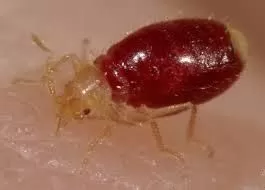
An effective bed bug control strategy must start with an inspection. A highly trained pest control professional, would start with a thorough inspection of all known and suspected spots where bed bugs might be hiding. Bed bugs are not pests that can be effectively controlled by do-it-yourself means. If bed bugs are detected your pest control professional will develop a customized treatment and control strategy with you that depends on the size of the infestation.
Bed bug sightings and infestations can cost you customers and reduce profits.
Rising complaints about these unwelcome guests are leading to red faces at the reception desks of hotels and an increase in the number of help calls. Even though they don’t pose a health threat, bed bugs, which live off human blood, can take a nasty bite out of a hotel’s reputation and business.
Specially Designed Mattress Protectors
To protect your family and your investment in bedding from bed bugs, we are happy to provide bed bug certified mattress and box spring encasements. They are waterproof, breathable, non-allergenic, fire retardant and impermeable to dust mites, mould, bacteria and of course, bed bugs. This luxurious fabric is soft to the touch while conforming to fit any mattress.
Since adult bed bugs can live for over a year after feeding, customers are advised to leave the encasements on their mattress for 18 months or longer.
Easy to Care For
For easy care, simply wipe down or vacuum the surface to eliminate dust mites and their allergens between linen washings.

What are the Signs of Bed Bugs?
You should regularly inspect all sheets and pillowcases for small brown blood stains (fecal spots) and inspect seams and folds of mattresses for live insects and bloodstains. Bed bugs usually stay close to the feeding areas so look for bed bugs in the areas where they congregate including along mattress seams, in the frames of beds or the headboards, behind baseboards and under carpet edges. Bed bugs can also hide behind pictures, door & window casings, loose wallpaper & any cracks.
Bed bugs typically hide during the daytime, so it can often be very difficult to spot them. If you don’t see the actual bed bugs look for tiny, rust-coloured stains that they leave behind on mattress tags and seams, ceilings, under seat cushions and behind headboards. Keep an eye out for blood stains on mattresses, sheets, pillows or bed clothes and keep an eye out for potential hiding places, such as buckling wallpaper or carpet, and conditions that can attract bed bugs like excessive heat or moisture.
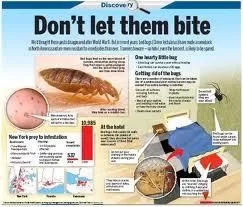
Bed bugs can hide just about anywhere; this is what makes detecting bed bugs can be so difficult. Typical hiding places are mattress seams, behind pictures, box springs, in curtains, behind headboards, in sofas, behind baseboards, bed frames, along carpet edges and night stands.
Bed bugs are not just in beds although they usually hide with in 3 to 6 feet of their feeding area.
Spotting The Signs Of Bed Bugs
You should regularly inspect all sheets and pillowcases for small brown blood stains (fecal spots) and inspect the seams and folds of mattresses for live insects and bloodstains.
Bed bugs usually stay close to the feeding areas so look in the areas where they congregate including along mattress seams, in the frames of beds or the headboards, behind baseboards and under carpet edges. Bed bugs can also hide behind pictures, door and window casings, loose wallpaper and any cracks.
Bed bugs typically hide during in the daytime, so it can often be very difficult to spot them. If you don’t see the actual bed bugs look for tiny, rust-coloured stains that they leave behind on mattress tags and seams, ceilings, under seat cushions and behind headboards.
Keep an eye out for potential hiding places, such as buckling wallpaper or carpet, and conditions that can attract bed bugs like excessive heat or moisture.
Once bed bugs are suspected…please contact us and follow the following steps after an inspection
All clothing or linens to be cleaned need to be sealed in plastic bags and taken immediately to the laundry area. (Typical laundering and tumble drying on HOT will kill all stages of bed bugs).
Empty all closets, wardrobes & drawers… and, if free of bed bugs, place contents in sealed plastic bags.
Make-up bags, alarm clocks and other items around bed should be thrown out and replaced when possible due to the difficulty in treating these items
Vacuum thoroughly, especially along carpet edges, baseboards, shelves, mattress seams and bed frame & headboard. (Dispose of vacuum bag immediately)
NEVER treat mattresses, or other contact surfaces with an insecticide. Instead, utilize a bed bug certified mattress encasement to protect your mattress.